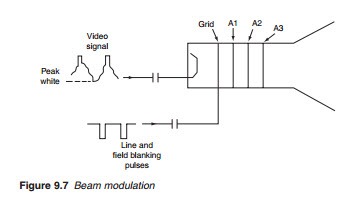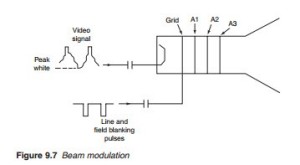Beam modulation
In order to produce an image on the tube, the brightness of the screen has to be varied as it scans the surface of the tube to recreates the picture information line by line. This is achieved by varying the intensity of the electron beam in accordance with the video signal, a process known as beam modulation. The beam is modulated by varying the potential between the
cathode and the grid. There are two types of modulation: grid modulation in which the cathode voltage is be held constant while the grid voltage is varied by the video signal and cathode modulation in which the voltage at the grid is fixed and that of the cathode is varied with the video signal. With cathode modulation the video signal is negative-going as shown in Figure 9.7. Peak white is produced when the cathode is at its most negative potential. In practice cathode modulation is normally used because of its greater sensitivity with negative-going blanking pulses applied to the grid to cut the beam off during line and field flybacks.

